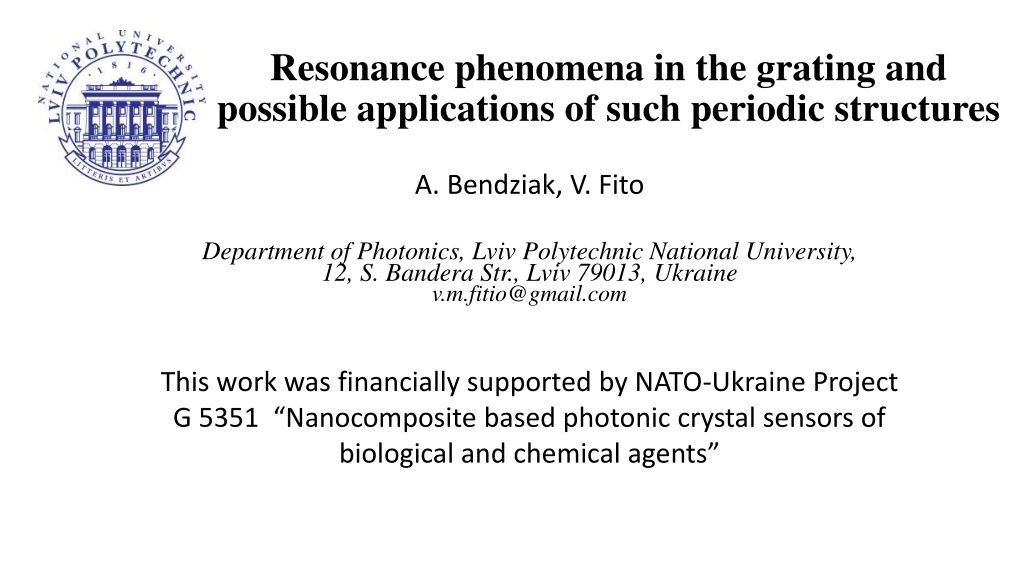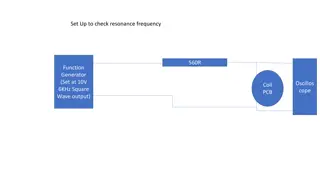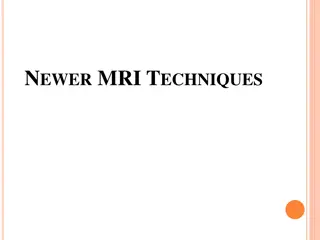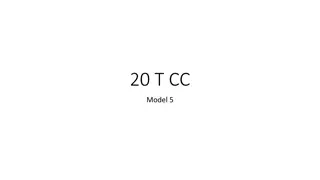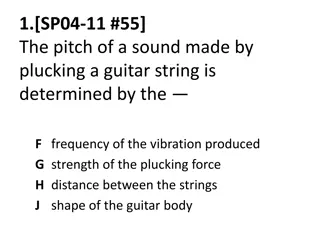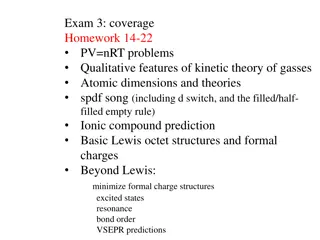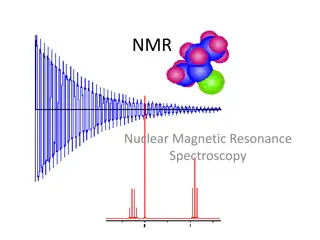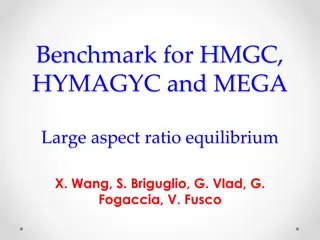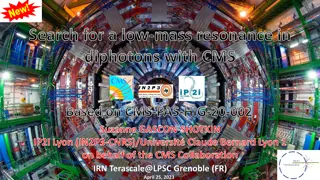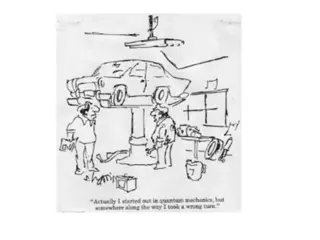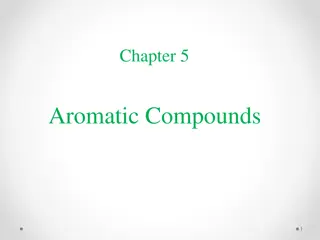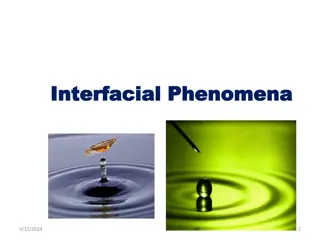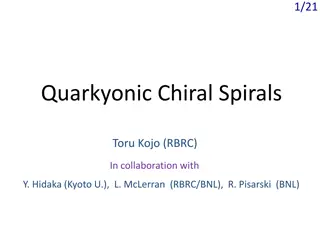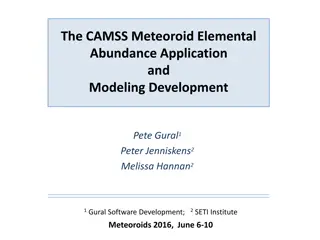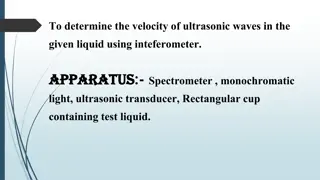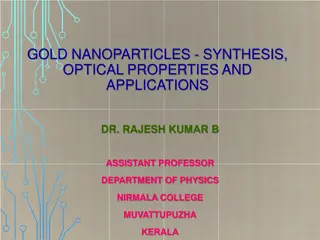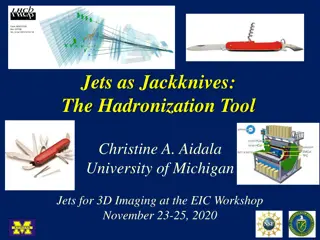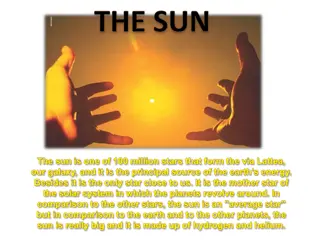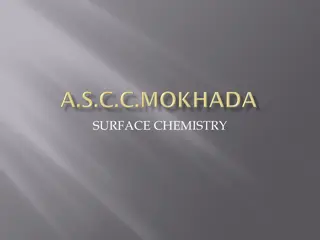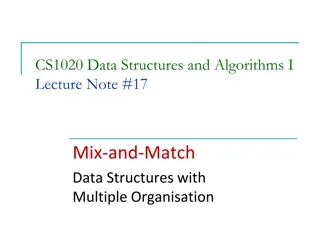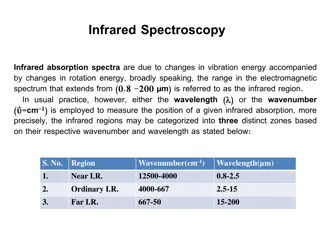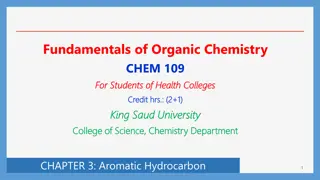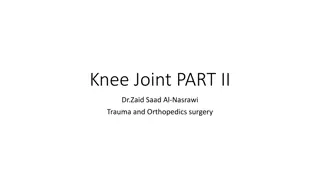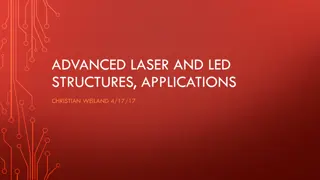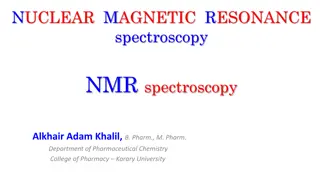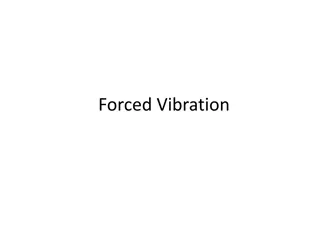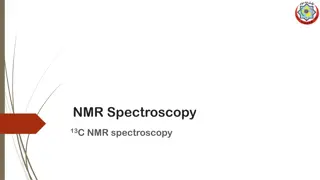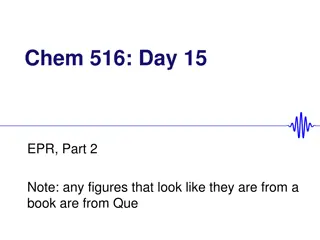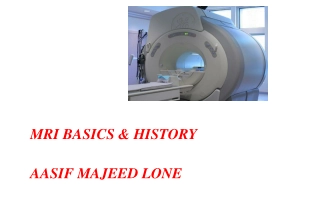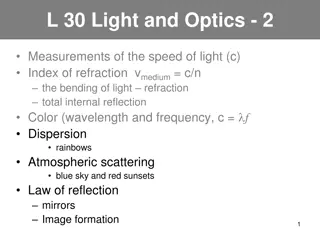Resonance Phenomena in Grating Structures and Applications
Resonance phenomena in grating structures, such as dielectric or metal gratings on substrates, offer sensitive elements for detecting biological and chemical agents. The sensitivity of these structures is described by equations relating to resonant wavelength changes and the refractive index of investigating solutions. Phase gratings exhibit sensitivity to incident angle and wavelength, affecting the resonant angle change. The distribution of electric field amplitudes in waveguide modes further enhances the understanding of these structures. Overall, these periodic structures show promise for various applications in sensing technologies.
Download Presentation

Please find below an Image/Link to download the presentation.
The content on the website is provided AS IS for your information and personal use only. It may not be sold, licensed, or shared on other websites without obtaining consent from the author. Download presentation by click this link. If you encounter any issues during the download, it is possible that the publisher has removed the file from their server.
E N D
Presentation Transcript
Resonance phenomena in the grating and possible applications of such periodic structures A. Bendziak, V. Fito Department of Photonics, Lviv Polytechnic National University, 12, S. Bandera Str., Lviv 79013, Ukraine v.m.fitio@gmail.com This work was financially supported by NATO-Ukraine Project G 5351 Nanocomposite based photonic crystal sensors of biological and chemical agents
Resonance phenomena in the grating and possible applications of such periodic structures Dielectric or metal grating on a metal substrate Volume phase grating Fig. 2. Grating with a rectangular profile, where is the grating period, 3= m is the dielectric constant of the metal (gold or silver), 1= 21= a, is the dielectric constant of the investigated medium, 22is the dielectric constant of the metal or dielectric. Fig. 1. A sensitive element based on a phase grating with a combined substrate
Phase grating Approximately resonance conditions can be written as: 2 sin 2 ,? Sensitivity of this structure is described by the following equations: ??= Sensitivity of the resonant wavelength change due to the change of the investigating solution s refractive index can be described as ? 2 sin ? ???,??=? ? . ?? ? = = . ?? 2
Phase grating And sensitivity of the resonant angle change is expressed as: ? ??? 2 cos ?? 2 cos . ?? = ???= ???= ? ??, 2 cos ??= where ? = We can see, that with increasing incident angle and wavelength, sensitivity increases.
Phase grating Fig. 3 shows the distribution of the square modulus of the electric field amplitude for the waveguide mode at a wavelength of 740 nm. Fig. 3. The distribution of the square modulus of the electric field amplitude for the waveguide mode at a wavelength of 740 nm, d=1.3 m, ng=1.525, thickness of the MgF2buffer layer 1 m, n=1.38, na= 1.5. Green curve - no buffer layer, ns = 1.515; blue curve - no buffer layer, ns = 1.45; red curve - substrate made of MgF2(ns = 1.332); green and blue dots - the buffer layer is present, respectively, with the refractive index of the substrate 1.515 and 1.45.
Phase grating Fig.5. Distribution of the field amplitude in the presence of a buffer layer in the substrate with a thickness of 1 m. Other parameters are the same as in Fig. 4. Fig. 4. The amplitude distribution of the field without a buffer layer in the substrate, with refractive index 1.515. Other parameters are the same as in Fig. 3. 6
Phase grating Fig.7. The angular dependence of the reflection coefficient of the grating at the wavelength =665 nm in the presence of the buffer layer, ns = 1.515, ng= 1.525, d = 1.3 m. Fig. 6. The spectral dependence of the reflection coefficient of the grating at the angle of incidence 20oin the presence of the buffer layer with a refractive index of na= 1.515, ng= 1.525, na=1.5, d = 1.3 m. 7
Phase grating Table 1 shows the resonant wavelengths for some angles and the sensitivity ??, ? , ?, ? for the following waveguide structure parameters: ??= 1.5,??= 1.38, ??= 1.525, ? = 1.3 ??. According to Table 1, the sensitivity S increases with increasing incidence angle of the test beam due to the increase of Snand increase of S (decrease in modulus), and S has a greater influence on the sensitivity S than Sn. It can be noted that the resonant wavelength changes significantly with increasing incidence angle on the sensitive structure. Table 1. Results of calculation of resonant wavelengths and sensitivities for some angles. Sn, ?? 1 S , ?? 2 res, ?? S, ?? ? ,????? ??????? 1 2 3 4 5 6 10 0.6735791 0.997 21.16 0.042 6.22 15 0.7072855 1.063 19.19 0.047 7.10 20 0.7402315 1.127 17.52 0.053 8.10 25 0.7721139 1.189 16.11 0.058 9.23 30 0.8027418 1.249 14.90 0.064 10.1 8
Phase grating The following table 2 shows the resonant wavelengths and sensitivities ??, ? , ?, ? depending on the refractive index naof the test medium at the incidence angle of the light beam 30oin the presence of the buffer layer. If there is no buffer layer, the data is given in the denominator of the cells in the table. Other parameters are: ??= 1.515, ??= 1.525, ? = 1.3 ??. Table 2. Results of calculation of resonant wavelengths and sensitivities for some refractive indices of the investigated medium. res, ?? Sn, ?? 1 S , ?? 2 2 3 4 0.7998599/0.804098 0.0169/0.0157 15.10/ 14.791 S, ?? 5 ? ,O 6 ?? 1 1 0.00084/0.00080 0.136/0.13 1.332 0.8004501/0.804253 0.0769/0.0186 15.06/ 14.798 0.00385/0.00095 0.619/0.16 1.35 0.8005246/0.804273 0.0884/0.0216 15.05/ 14.798 0.0044/0.0011 0.710/0.18 1.4 1.45 1.5 0.8008052/0.804351 0.8013104/0.804496 0.8027418/0.804951 0.1423/0.0361 0.288/0.0778 1.249/0.3973 15.03/ 14.795 14.99/ 14.791 14.90/ 14.775 0.0071/0.0018 0.0145/0.00396 0.0639/0.0202 1.147/0.31 2.325/0.66 10.09/3.37
Phase grating Table 3 shows the resonance angles resfor the wavelength of the test laser 665 nm for different refractive indices of the test medium in the presence of the buffer layer with the refractive index of 1.38, ??= 1.515, ??= 1.525, ? = 1.3 ??. Table 3. Results of calculation of resonant incidence angles and angular sensitivities for some refractive indices of the studied environment. ?? res ? , ????? ??????? Sn, ?? 1 1 2 3 4 1 9.014702 0.0128 0.0788 1.332 8.599422 0.0590 0.360 1.35 8.952432 0.0679 0.417 1.4 8.926031 0.1100 0.681 1.45 8.878374 0.2234 1.37 1.5 8.739596 0.9801 6.01
Phase grating As we can see from Table 3, the angular sensitivities increase with the increase of the refractive index of the test medium. Moreover, a particularly sharp increase is observed when the refractive index of the test medium approaches the grating refractive index. The half-width of the spectral curve is 0.5= 0.003 nm. From Table 1 follows that the sensitivity S = 53 nm at the incidence angle of the beam 20ofor the refractive index of the test medium 1.5. If the refractive index change is 0.0001, then the change in the resonance wavelength will be 0.0053 nm, which is about 1.8 times the spectral width of the resonance curve. At a wavelength of 665 nm, the angular sensitivity (see Table 3) to the change in the active medium is 6.01angle degrees. If the refractive index of the active medium changes by 0.0001, then the resonance angle will change by 0.0006 angle degrees, which corresponds to 2.16 arcseconds, which is about 7 times the angular width of the resonance curve. That is, theoretical analysis shows that the sensor based on the phase grating can sense a change in the refractive index of the study environment 0.0001. 11
Dielectric or metal grating on the metal substrate With resonant excitation of a surface plasmon-polariton wave with normal incidence of a plane wave, the following conditions must be satisfied. At resonance the reflection coefficient is zero. 2? Re 2? ? ???? ??+??, ??= ?? 2 Based on this relationship, it is possible to calculate the sensitivity of the resonant wavelength to a change in the refractive index of the test material ? ? ?? 12
Dielectric or metal grating on the metal substrate Resonance absorption of the electromagnetic wave energy is observed at carefully selected parameters of the grating and wavelength. The grating parameters and the resonant wavelengths are given in Table 4 for a silver substrate. Table 4. Parameters of periodic structures with silver substrate and resonances wave lengths defined by the RCWA and FEM dres, nm (RCWA) 1 2 3 4 25 1 Ag 0.857 1.0184 50 1 Ag 0.143 1.0035 13.4 1 Ag 0.5 1.0109 50 1 9 0.857 1.1469 55 1 9 0.143 1.0251 129.1 1 2 0.5 1.073 res, m, res, m, (FEM) 6 1.0181 1.0039 1.0107 1.1450 1.0244 1.0722 1 22 F , nm 5 7 1 2 3 4 5 6 1.1 0.6 0.8 6 2.3 2.5 13
Dielectric or metal grating on the metal substrate Comparison of columns 5 and 6 shows a good fitting of the resonant wavelengths determined by two methods. The angle of incidence of the optical wave on the grating is normal in all calculations. The grating period is 1 m for all examples. Figure 2 shows the spectral dependence of the reflection coefficient for the structure number 3. The width of the resonance curve is equal to 0.8 nm, that is, the Q-factor is equal to Q = res/ =1264. Therefore, such structures can be used as sensitive sensor elements. Fig.8, Spectral dependence of the reflection. Dots are calculated by RCWA and the continuous curve is described by the Lorentz function. 14
Dielectric or metal grating on the metal substrate The distribution of the electric field above the grating for the periodic structure No.3 is shown in Fig. 9. It can be seen that the strongest field is concentrated in a rather small volume. Fig. 10 shows the distribution of the magnetic field above the grating. It should be noted that the strongest field occupying a significant volume above the grating. Fig. 9. Distribution of the electric field above the grating near the right angle in the metal at the resonant wavelength of 1010.7 nm for the periodic structure No. 3. Fig.10. The distribution of the magnetic field in the grating at a resonant wavelength of 1010.7 nm for the periodic structure No. 3. 15
Dielectric or metal grating on the metal substrate It is known that gold is more resistant to external influences, and its characteristics from the point of view of the resonance of plasmon-polariton waves are slightly worse than silver. Table 5 shows the parameters of the SPP resonance for the gold substrate. The angle of incidence of the optical wave on the grating is normal in all calculations. In addition, the width of the resonances for the gold substrate is greater than for the silver substrate. This is due to the fact that the imaginary part of gold dielectric permittivity is higher than the imaginary part of the silver permittivity. Table 5. Parameters of periodic structures with gold substrate and resonances wave defined by the RCWA and FEM. , nm dres, nm 1 22 F res, m, (RCWA) res, m, (FEM) , nm 1 2 3 1 1 4 5 6 7 8 1000 1000 750 14.81 55 55.3 Au 9 9 0.5 0.16 0.2 1.0124 1.03417 1.0519 1.0125 1.03421 1.0519 1.3 2.6 6.1 1.777 16
Dielectric or metal grating on the metal substrate The distribution of the electric field in the periodic structure at the resonant wavelength is shown in Fig. 11. It can be seen that the strongest field is concentrated in a fairly small volume. Therefore, the strong field will come in contact with the test substance in a small volume. However the magnetic field takes up a significant volume above the grating and will strongly interact with the test substance. Fig. 12 shows the distribution of the magnetic field in the grating on gold substrate. The enhanced field occupies a considerable volume above the grating. Fig. 11. Distribution of the electric field above the grating near the right angle in the metal at the resonant wavelength of 1012.5 nm for the periodic structure No 1. Fig.12. The distribution of the magnetic field in the grating at a resonant wavelength of 1012.5 nm for the periodic structure No 1. 17
Dielectric or metal grating on the metal substrate Fig. 13 shows the change in the wavelength of the resonance for the structure No 2 (Fig. 13a) and No 3 (Fig. 13b) from Table 5. It can be concluded from Fig. 13 that there is the strong linear dependence of the change in the resonant wavelength on the change in the refractive index. The sensitivity for structure 2 will be 910 nm (gas), and for structure 3 (water solutions) the sensitivity is equal to 670 nm. The change in the resonant wavelength is proportional to the change in the refractive index of the medium. Fig. 13 Dependences of the change in the resonance wavelength on the refractive index of medium which contacts with the dielectric grating on the metal substrate for gas media (a) and aqueous solutions (b).
Dielectric or metal grating on the metal substrate Thus, it is appropriate to use such a structure (Fig. 10) to study luminescence excited by magnetic-dipole interaction. The strong magnetic field is concentrated in the dielectric for the dielectric grating (No. 2 and 3 of Tabl. 5) on the gold substrate and this field will not contact with test the substance. However, there is a strong electric field in these structures, which occupies a large volume above the grating. It is obviously that such structures under plasmon-polariton resonance are expediently used for Raman spectroscopy and to the study of luminescence excited during electrically dipole interaction. Structure No. 3 can be used to study the aqueous solutions of active substances, because the wavelength of the resonance is determined by the refractive index of the solution. 19
